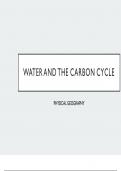Presentation
A* Water and Carbon Cycle with CASE STUDIES- AQA A-level Geography
- Course
- Institution
- Book
An in-depth set of notes for A-Level Physical Geography- Water and Carbon cycle topic. Notes include case studies and examples. I achieved A* in the 2022 A-Levels using these notes, it includes everything on the specification.
[Show more]













